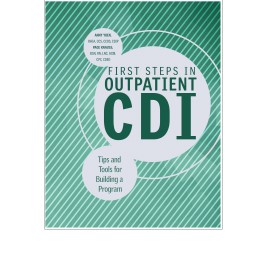Book excerpt: Determining a return on investment for outpatient CDI

outpatient CDI? ACDIS has
a resource for you!
The first step in determining the impact of an outpatient CDI program and its return on investment (ROI) is evaluating the amount of outpatient care the organization provides. Once the organization confirms a solid base for volume, and type, of services provided, the billing process should be analyzed to determine weak points in the documentation and reimbursement process.
Next, the organization should determine which outpatient services will be included in the outpatient CDI program. Ideally, all outpatient services would be included in every program, although limited funds and resources may reduce the scope of some programs. When confirming where an outpatient CDI program will have the most impact, a facility must decide whether to assess all outpatient services simultaneously or prioritize and assess services individually. From there, the organization should decide whether assessments will be performed internally or externally through a consulting firm or other source. One option is to analyze data by Ambulatory Payment Classification (APC) to determine where high volumes appear. Another way to analyze outpatient data is to aggregate APCs.
Some facilities may opt to analyze data by line of service, such as cardiac care, outpatient surgery, or physician clinics. Although this methodology makes sense for many organizations, facilities should cross-reference data with APCs to avoid missing significant volume, denial, or reimbursement opportunities.
When establishing criteria for selection of outpatient visit types, consider those with the highest revenue, highest volume, highest rejection rates, and highest number of unbilled rates. CDI specialists may also opt to meet with providers and discuss their documentation practices to identify potential issues and areas of improvement.
The other side of the equation involves outpatient billing and outpatient payments. The difference between outpatient billing and outpatient payments is the denied claims. The basic equation for calculating CDI impact in the outpatient setting is as follows:
Estimated impact = Outpatient service provided - (Outpatient billing - denied claims)
Say, for example, that a facility determined that they provided outpatient services to 60,000 patients per month. The hospital bills $18 million in outpatient care per month and takes roughly $2 million in payer denials each month. The facility determined that the hospital was providing $16.8 million in outpatient care, or about a 5% more than what was consistently being billed per month. The monthly outpatient CDI program, assuming 100% capture of all services provided and a 50% reduction in denials, would be $1.8 million per month ($800,000 in additional reimbursement and $1 million in decreased denials). The next impact of the CDI program would then be the financial return minus the cost of implementing the outpatient CDI program.
Healthcare organizations typically track outpatient services billed, services paid, and denials through financial report cards of some type. CDI professionals can work with their finance department to obtain a realistic picture of the potential impact of improved documentation.
Editor’s note: This article is an excerpt from the book First Steps in Outpatient CDI: Tips and Tools for Building a Program.
